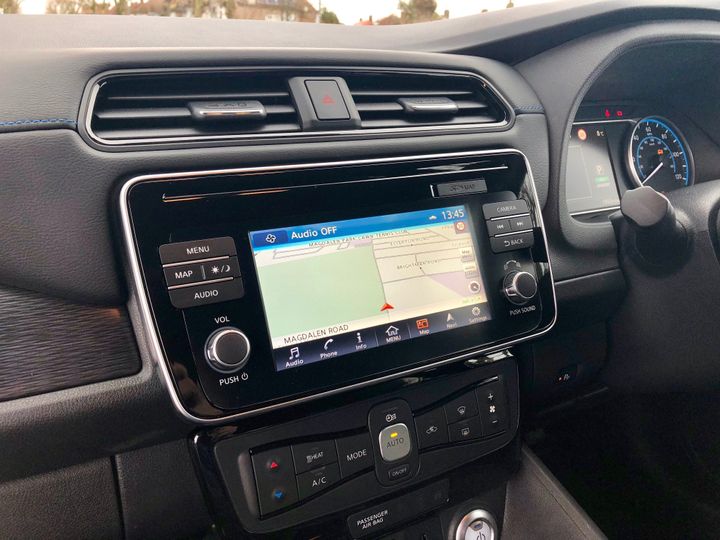
K E Y P O I N T S

The new Nissan Leaf is a fully electric car comes with a range of 235-miles.
Unlike other electric cars the Leaf feels within the realms of affordability: it starts at £21,990, compared with say BMW’s i3 which starts at around £33,000.
It also comes with something called e-Pedal. This allows ‘one pedal driving’ by braking as you release your foot off the accelerator. It is incredibly weird to start with but once you get the hang of it it genuinely changed my driving style to be more economical.
The Leaf can come with Nissan’s self-driving technology, ProPILOT, which will accelerate, brake and even steer while the car is on the motorway or in slow-moving traffic. It’s brilliant – as good as any other self-driving technology we’ve tested.
For an electric car the media system feels agonisingly dated. The screen is low resolution, slow to respond and the SatNav looks like something you’d find in Windows 95.
The interior won’t win any design awards but it is functional and there’s plenty of storage space for four.
The boot is HUGE, even with giant charging cables snaking around it.
V E R D I C T

Before Elon Musk wowed us all with the Tesla Model S there was the 2010 Nissan Leaf. It wasn’t perfect, in fact when I drove it from London to Essex it was a terrifying experience that involved religiously sticking to 55mph and keeping the AC permanently off for fear that I would run out of electricity. Oh and driving it was like sailing a bathtub through treacle.
Yet it had its charm, it cost pennies to run and for those forward-thinkers not driving epic distances everyday, it offered a way of saving money.

Almost a decade later there’s a new Nissan leaf: it now has a range of 235-miles, can be charged to 80% in just 40mins, and can drive itself even in slow-moving city centres.
Although it feels pretty good when you’re driving yourself. The steering is sharp and light while, thanks to the Leaf’s powerful electric motor, it has a seriously zippy 0-60mph. The ride is firm but not uncomfortable and actually sounds truly silent when you drive. It’s blissful. (Unless maybe you’re a cyclist or a pedestrian keeping an ear out.)
As you can see this new Nissan Leaf looks a lot better than the old one. Gone is the old design and instead this looks more like a hot hatchback than what is ostensibly a large family car.

Inside, the Leaf is slightly less wow and considerably more sensible. Too sensible in fact. Nissan appears to have completely forgotten the concept that just because something is affordable, doesn’t mean it has to be unexciting.
The interior looks and feels about as futuristic as Windows 95, which is a real shame. Considering the industry’s desire to actively move people over to electric cars, this feels like a missed opportunity.
There is half a digital screen behind the wheel which offers a glimmer of technological hope, but is actually quite confusing to navigate. And the screen in the centre console is not great. Car manufacturers who won’t use high-resolution touchscreen displays for their cars are frustrating: it’s not technically difficult, yet so many skimp on the display. The result is something that’s low-resolution and really slow to respond.
Thankfully the Leaf supports CarPlay and Android Auto so you can run both Apple and Google’s own operating system through the screen by plugging your phone in via USB. I would 100% recommend doing this.

The car’s range is well over 180-200 miles in everyday use. Thanks to fast-charging dotted around London (the fast-charging network is actually pretty good around the UK) and the fact it takes less than 7 hours to charge overnight, I never found myself worrying about range in the week I drove the Leaf.
The car’s extra driving features such as ProPILOT are also impressive – this car can essentially drive itself in traffic. It’s a fantastically lazy thing to do but if you’re someone who spends hours in traffic during rush hour, it could be a shining ray of light you’ve been waiting for. What’s as impressive is that it’s actually only a £400 extra on the Leaf’s mid-range N-Connecta model and standard on the top-of-the-range Tekna.
The e-Pedal, which turns the accelerator into a brake when you pull your foot back, feels deeply odd to begin with. But you do get used to it, and the premise is that you can do everything with one foot.
S P E C I F I C A T I O N S

- Car tested: Nissan Leaf Tekna
- Engine: 40kWh battery
- Range: 235 miles NEDC
- Top Speed: 89.5mph
- 0-60mph: 7.9 sec
- Cost: The model I drove costs £28,755 OTR
- Features: This model came with ProPILOT which gives the car partially self-driving abilities on motorways and on roads. It’s standard with the Tekna model but a £400 extra on N-Connecta.
T A K E H O M E M E S S A G E

Nissan have accomplished something special with the Leaf. Despite its uninspiring interior, after a week driving it, I’m genuinely excited for the future of electric vehicles.
Somehow Nissan has managed to create a fully-electric car that has a range of 200+ miles, great storage, the ability to self-drive in the cities and on the motorway – AND the entry-level model starts at around £21,000. For comparison, the Tesla Model S I drove to Glasgow cost over £100,000.
If Nissan can offer that value for money, then I can’t wait to see what the competition have got up their sleeves.
